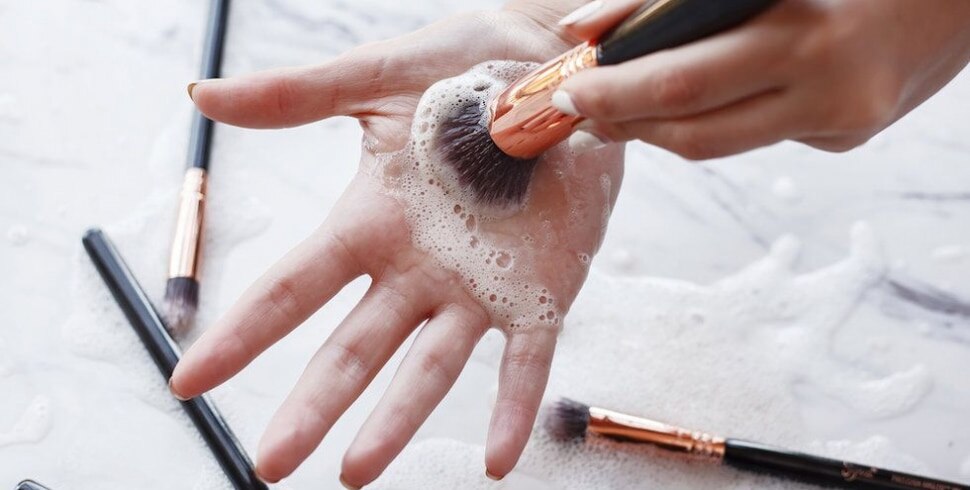Have You Been Cleaning Your Makeup Tools? Here's How and Why You Should
Beauty experts at purplle.com share *exactly* how and why you need to undertake the daunting task of cleaning your brushes and blenders.

When it comes to makeup, all our attention is focused on application—"How to ace a winged eyeliner?", "Do I pick a concealer shade lighter than my skin tone?", "Where do I apply a bronzer?" More often than not, cleansing isn't even spoken of.
Considering that we use a range of beauty products on our skin—day-in, day-out—hygiene must be of utmost importance. After all, we don't want to be dealing with brushes, blenders and bacteria! If you want all the time that you spending glamming up to be worth it in the end, take note of these several reasons why you should clean out your makeup tools regularly.
Acne, Oh My!
The makeup brushes that you utilise to apply makeup on your face also often get rid off dust, bacteria, oil and dead skin cells in the process. Thereby, the next time you go for the same brush when applying makeup, know that you are inviting a multitude of germs and toxins to your skin. Besides, the residual makeup on your tools can give way to acne eruptions and skin irritations.
Diminished Quality of Makeup
Avoiding cleaning your makeup tools can also severely impact the quality of makeup application and blending. You will gradually notice that the tools have become ineffective in helping you achieve the desired look. Alternatively, clean makeup tools will help with seamless, flawless application.
Harsh For Sensitive Skin
Makeup brushes when used multiple times can become rough. Hence, their harsh bristles will brush against your skin, causing skin redness, irritation and inflammation. By regularly and effectively cleaning out your brushes, you will ensure that the bristles are soft on your skin.
A Breeding Ground For Infections
Were you aware that your dirty brushes can lead to viral infections? In case of repeated use of unclean makeup brushes or those which you have shared with others, there will be a continuous transfer of germs. One of the many causes of conjunctivitis is sharing beauty products! It's simply because you can never be certain about how well someone else cleans their lip brush or makeup sponge. Therefore, stick to using your own sanitized tools.
Safeguard Your Beauty Products From Bacteria
If you fail to cleanse your makeup tools, you're not solely exposing your skin to germs, but also your treasured makeup products. The dark, moist environment of makeup storage spaces and the texture of products can pose to be a breeding ground for bacteria. This ends up being unhealthy for your skin, as well as the product which can now break down much more easily.
Now that you've learnt the 'why' behind cleaning your makeup tools, wondering 'how' to go ahead with it? Beauty experts at purplle.com have got your back.
1) In order to clean your makeup brush, wet the bristles of the brush with lukewarm water. However, ensure that the water that you use isn't too hot. Add a mild shampoo to the mug filled with lukewarm water and swirl the brushes, while massaging the tips of the bristles to remove the dirt. Squeeze out the excess water with the help of a clean towel. Allow the brushes to self-dry—hanging off the edge of a counter—which keeps their shape intact. Try following this cleaning process at least once every week.
2) Alternatively, to thoroughly clean the makeup brushes you can buy a silicone brush cleaner, available at most cosmetic stores. The cleaner will properly massage the bristles of your brush, leaving no bacteria on its surface.
3) Colorbar offers a 'Clean-On-The-Go Makeup and Tools Sanitizing Mist', that is available on purplle.com. It is an anti-bacterial spray that kills surface germs—on both powder and cream-based products—and reduces bacterial growth on your products and tools. It can be used on makeup brushes, tweezers, beauty blenders etc.
4) Make sure to clean your beauty blenders at least once a week. Makeup sponges often accumulate skin cells, leading to bacterial overgrowth. Since blenders and sponges are primarily used to seamlessly apply liquid and cream-based makeup products to your skin—including foundation, concealer and highlighter—it's essential to clean the tool in an appropriate manner. Begin by dampening the blender. Next, pour a small amount of cleanser onto the blender. Massage the cleanser well into the blender to loosen the residual makeup. Rinse and squeeze out the excess water and repeat if necessary. Leave your blender out on a towel to dry, then store it in a cool, dry place.
Last but not the least, you should know when's the right time to throw away your makeup brushes—when the bristles start to shed or lose their original shape!
more from Beauty

Why young people are ‘retiring’ early at this viral Malaysian retreat

#CosmoKinkyFaves: The cheeky edit of the 50 sex toys that’s got everyone buzzing

From Labubus to Hello Kitty—ten tiny things adults are still holding on to for comfort in 2026

Breaking the confidence myth—why you actually don’t need to have it all figured out

#CosmoKinkyFaves: The top 50 must-have lingerie pieces to help you feel confident and sexy

#CosmoKinkyFaves: The top 50 best songs that deserve to be on every sex playlist

Why your situationship might actually be your best sex

Same trousers, same top cut—how the repeat silhouette is turning outfits into personal uniforms

These cosy cardigans will help you tap into the "granny chic" trend

'Heated Rivalry' season 2 is coming—and here’s what the books promise
